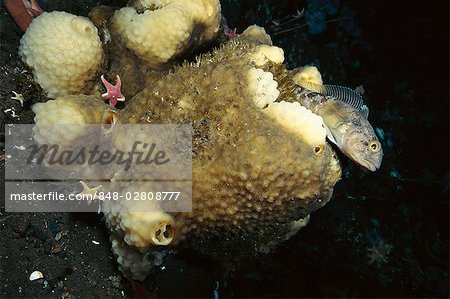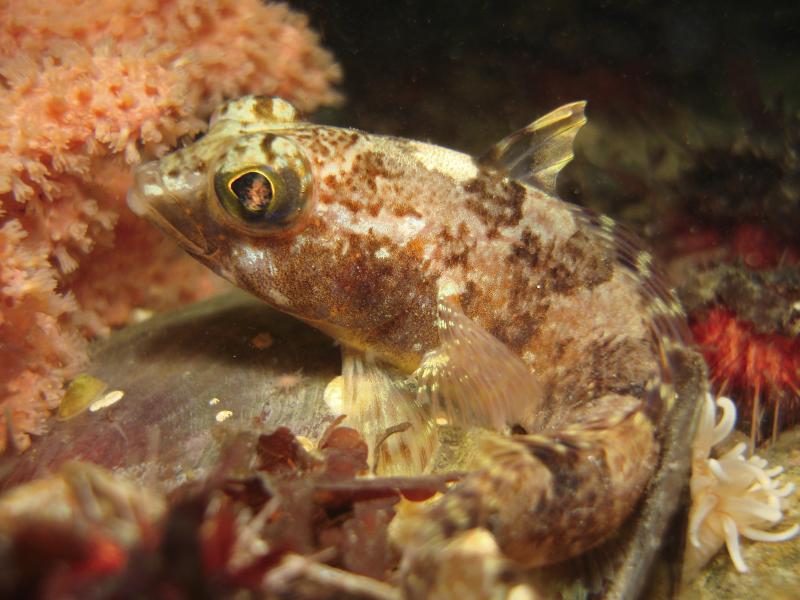
Trematomus bernacchii
FAMILY
Nototheniidae
TAXONOMY
Trematomus bernacchii Boulenger, 1902, Cape Adare and Duke
of York Island, North Victoria Land, Antarctica.
OTHER COMMON NAMES
English: Emerald rockcod, bernak; French: Bocasson йmeraude;
Russian: Trematom-pestryak; Spanish: Austrobacalao esmerelda.
PHYSICAL CHARACTERISTICS
Reaches a maximum length of 12 in (30 cm) and a maximum
weight of 12.3 oz (350 g). It is thick-bodied (length/depth ratio,
about 3:9) and light brown to pinkish brown on the sides,
with irregular darker blotches; the belly is silvery gray. It is
covered with ctenoid scales, except for a patch between the
eyes, where there may be a single row of scales. Three distinct
color varieties are known:
• continuous white band across the nape and opercula
• an interrupted band, consisting of a narrow medial
stripe on the nape and on each operculum
• no white marking
DISTRIBUTION
Coastal waters of Antarctica, including the Antarctic Peninsula
and South Shetland and South Orkney Islands.
HABITAT
It is most common on boulder, rock, or gravel bottoms or in
sponge beds at depths of 18–1,200 ft (5–370 m), but it has
been caught as deep as 2,280 ft (700 m). Smaller individuals
are found in shallow water, whereas mature fish are more common
in deeper water.
BEHAVIOR
The emerald notothen is a sedentary demersal species, spending
most of its time immobile on the bottom. It swims infrequently
and slowly, sculling with the pectoral fins and making
short excursions across the bottom or ascending about 3 ft (1
m) into the water column. In the aquarium, dominant individuals
establish and defend territories.
FEEDING ECOLOGY AND DIET
This is an opportunistic feeder and scavenger, primarily on
benthic invertebrates. Small crustaceans are the most common
dietary item, followed by polychaetes, molluscs, fish, and fish
eggs. It ingests seaweed, but its nutritional contribution is unknown.
REPRODUCTIVE BIOLOGY
The life span of the emerald notothen is 8–10 years; in
McMurdo Sound, first spawning occurs at five years. Females
spawn biennially; initial oocyte development takes one year and
active vitellogenesis (deposition of yolk within the growing egg)
another year. Spawning takes place over a brief period, from
October to November in Adйlie Land and December to January
in McMurdo Sound. Fecundity is on the order of 1,500–
3,000 eggs, which are attached to rocks, algae, or sponges;
mature eggs are 0.16 in (4 mm) in diameter. There are reports
that the emerald notothen tends egg masses in sponges.
CONSERVATION STATUS
Not threatened. The emerald notothen is widespread and common;
considering its small size and high latitude, it is not likely
to come under any significant pressure from fisheries. Its limited
mobility probably would lead to extremely rapid depletion
of any local populations that might be subjected to commercial
fishing.
SIGNIFICANCE TO HUMANS
This species has played an important scientific role in the
study of anatomical, physiological, and biochemical adaptations
to the Antarctic environment. Most significantly, it has featured
prominently in the elucidation of biological antifreeze
compounds.
Photo Gallery of - Emerald notothen





 Animalia Life
Animalia Life